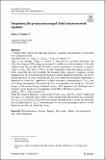| dc.contributor.author | Hanlon, Robert T. | |
| dc.date.accessioned | 2024-05-06T16:09:53Z | |
| dc.date.available | 2024-05-06T16:09:53Z | |
| dc.date.issued | 2024-04-30 | |
| dc.identifier.issn | 1386-4238 | |
| dc.identifier.issn | 1572-8463 | |
| dc.identifier.uri | https://hdl.handle.net/1721.1/154839 | |
| dc.description.abstract | J. Willard Gibbs derived the following equation to quantify the maximum work possible for a chemical reaction
$${\text{Maximum work }} = \, - \Delta {\text{G}}_{{{\text{rxn}}}} = \, - \left( {\Delta {\text{H}}_{{{\text{rxn}}}} {-}{\text{ T}}\Delta {\text{S}}_{{{\text{rxn}}}} } \right) {\text{ constant T}},{\text{P}}$$
Maximum work
=
-
Δ
G
rxn
=
-
Δ
H
rxn
-
T
Δ
S
rxn
constant T
,
P
∆Hrxn is the enthalpy change of reaction as measured in a reaction calorimeter and ∆Grxn the change in Gibbs energy as measured, if feasible, in an electrochemical cell by the voltage across the two half-cells. To Gibbs, reaction spontaneity corresponds to negative values of ∆Grxn. But what is T∆Srxn, absolute temperature times the change in entropy? Gibbs stated that this term quantifies the heating/cooling required to maintain constant temperature in an electrochemical cell. Seeking a deeper explanation than this, one involving the behaviors of atoms and molecules that cause these thermodynamic phenomena, I employed an “atoms first” approach to decipher the physical underpinning of T∆Srxn and, in so doing, developed the hypothesis that this term quantifies the change in “structural energy” of the system during a chemical reaction. This hypothesis now challenges me to similarly explain the physical underpinning of the Gibbs–Helmholtz equation
$${\text{d}}\left( {\Delta {\text{G}}_{{{\text{rxn}}}} } \right)/{\text{dT}} = - \Delta {\text{S}}_{{{\text{rxn}}}} \left( {\text{constant P}} \right)$$
d
Δ
G
rxn
/
dT
=
-
Δ
S
rxn
constant P
While this equation illustrates a relationship between ∆Grxn and ∆Srxn, I don’t understand how this is so, especially since orbital electron energies that I hypothesize are responsible for ∆Grxn are not directly involved in the entropy determination of atoms and molecules that are responsible for ∆Srxn. I write this paper to both share my progress and also to seek help from any who can clarify this for me. | en_US |
| dc.publisher | Springer Science and Business Media LLC | en_US |
| dc.relation.isversionof | 10.1007/s10698-024-09503-3 | en_US |
| dc.rights | Creative Commons Attribution | en_US |
| dc.rights.uri | https://creativecommons.org/licenses/by/4.0/ | en_US |
| dc.source | Springer Netherlands | en_US |
| dc.title | Deciphering the physical meaning of Gibbs’s maximum work equation | en_US |
| dc.type | Article | en_US |
| dc.identifier.citation | Hanlon, R.T. Deciphering the physical meaning of Gibbs’s maximum work equation. Found Chem (2024). | en_US |
| dc.contributor.department | Massachusetts Institute of Technology. Department of Chemical Engineering | |
| dc.identifier.mitlicense | PUBLISHER_CC | |
| dc.eprint.version | Final published version | en_US |
| dc.type.uri | http://purl.org/eprint/type/JournalArticle | en_US |
| eprint.status | http://purl.org/eprint/status/PeerReviewed | en_US |
| dc.date.updated | 2024-05-05T03:14:51Z | |
| dc.language.rfc3066 | en | |
| dc.rights.holder | The Author(s) | |
| dspace.embargo.terms | N | |
| dspace.date.submission | 2024-05-05T03:14:51Z | |
| mit.license | PUBLISHER_CC | |
| mit.metadata.status | Authority Work and Publication Information Needed | en_US |
